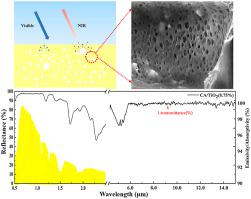Optical Materials ( IF 3.9 ) Pub Date : 2021-08-04 , DOI: 10.1016/j.optmat.2021.111431 Xi Chen 1 , Man He 1 , Shuangjiang Feng 1 , Zhengjian Xu 1 , Hao Peng 1 , Shengnan Shi 1 , Chenghuan Liu 1 , Yuming Zhou 1

|
Passive daytime radiative cooling materials significantly alleviate the current energy shortage and global warming without consuming any energy. However, conventional inorganic nanoparticles can hardly achieve excellent cooling effect during daytime due to their low reflectivity. Broadband super white nanoparticle-based radiators demonstrate excellent solar reflectivity under direct sunlight and low absorption. Accordingly, we introduced TiO2 nanoparticles with the advantages of high refractive index, high infrared emissivity and low solar absorption into the porous cellulose-based film via a facile phase separation strategy. The cavities were distributed around 5 μm in size due to the limited evaporation of solvents, while the introduction of TiO2 nanoparticles effectively enhanced the solar reflectance to 0.97. Moreover, the scattering model demonstrated that the high solar reflectivity was mainly produced by the randomly agglomerate effect of nanoparticles and these nano-clusters also contribute to a high mid-infrared emissivity. As a result, the photonic film presented about 10 °C cooling capacity even under the high-density solar radiation (~897 W/m2) according to the out-door measurement. The random nano-clusters filling strategy avoids the complicate process of specific size particles and has a significant potential for propel the polymer-based cooling technology to satisfy the need of large-scale thermal management.
中文翻译:

具有自动沉积 TiO2 的纤维素基多孔聚合物薄膜作为用于被动日间辐射冷却的光谱选择性材料
被动式日间辐射冷却材料在不消耗任何能源的情况下显着缓解了当前的能源短缺和全球变暖。然而,传统的无机纳米粒子由于其反射率低,在白天很难达到出色的冷却效果。基于宽带超白纳米颗粒的散热器在阳光直射和低吸收率下表现出出色的太阳能反射率。因此,我们通过简单的相分离策略将具有高折射率、高红外发射率和低太阳能吸收率的TiO 2纳米粒子引入多孔纤维素基薄膜中。由于溶剂蒸发有限,空穴分布在 5 μm 左右,而 TiO 2的引入纳米粒子有效地将太阳反射率提高到 0.97。此外,散射模型表明,高太阳反射率主要是由纳米粒子的随机团聚效应产生的,这些纳米团簇也有助于高中红外发射率。结果,根据户外测量,即使在高密度太阳辐射(~897 W/m 2)下,光子膜也表现出约 10 °C 的冷却能力。随机纳米团簇填充策略避免了特定尺寸颗粒的复杂过程,并具有推动基于聚合物的冷却技术满足大规模热管理需求的巨大潜力。



























 京公网安备 11010802027423号
京公网安备 11010802027423号